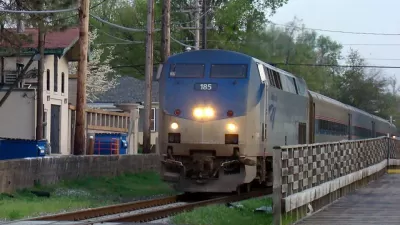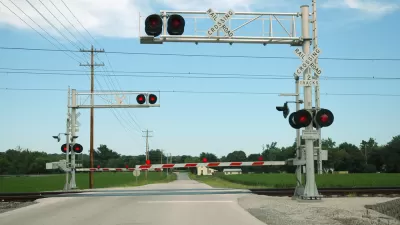A $102 million investment by Illinois along with federal funds from the Recovery Act will pay for double-tracking and a new rail bridge to enable 109 mph service on a key section of Amtrak's Chicago to St. Louis high speed rail corridor.
This particular corridor was the first of many listed by Time's Michael Grunwald last month in the post, "Responding to Distorted Criticisms of the President's High Speed Rail Program," that illustrated results of the president's ambitious high speed rail stimulus program in response to false claims by critics that the program is a failure.
"A key swath of the high-speed rail line between Chicago and St. Louis is set to get $102 million in upgrades, Gov. Pat Quinn announced on Sunday (August 31)," writes Matt McKinney of the Chicago Sun-Times.
The two-year project will reduce travel times between Chicago and St. Louis from five-and-a-half hours to four-and-a-half hours, Quinn said in a written statement..
The work will be performed by the Union Pacific Railroad and overseen by the Illinois Department of Transportation (IDOT), according to IDOT news [PDF]. Amtrak's Illinois Service operates on the corridor.
"This double-tracking [between downstate Mazonia and Elwood] will then allow more daily round-trips at increased 110-mph speeds. Trains now travel at 110 mph between Dwight and Pontiac," adds McKinney.
A map [PDF] of the route and multi-media are available on IDOT's High Speed Rail project page.
"The state has committed $358.8 million to the Chicago-St. Louis route, with the remainder of the $1.7 billion project federally funded," notes McKinney.
[Hat tip to Adam Snider of Politico for including the article in Tuesday's Morning Transportation].
FULL STORY: Quinn announces $102 million investment for high-speed rail

Study: Maui’s Plan to Convert Vacation Rentals to Long-Term Housing Could Cause Nearly $1 Billion Economic Loss
The plan would reduce visitor accommodation by 25,% resulting in 1,900 jobs lost.

North Texas Transit Leaders Tout Benefits of TOD for Growing Region
At a summit focused on transit-oriented development, policymakers discussed how North Texas’ expanded light rail system can serve as a tool for economic growth.

Why Should We Subsidize Public Transportation?
Many public transit agencies face financial stress due to rising costs, declining fare revenue, and declining subsidies. Transit advocates must provide a strong business case for increasing public transit funding.

How Community Science Connects People, Parks, and Biodiversity
Community science engages people of all backgrounds in documenting local biodiversity, strengthening connections to nature, and contributing to global efforts like the City Nature Challenge to build a more inclusive and resilient future.

Alabama: Trump Terminates Settlements for Black Communities Harmed By Raw Sewage
Trump deemed the landmark civil rights agreement “illegal DEI and environmental justice policy.”

Dear Tesla Driver: “It’s not You, It’s Him.”
Amidst a booming bumper sticker industry, one writer offers solace to those asking, “Does this car make me look fascist?”
Urban Design for Planners 1: Software Tools
This six-course series explores essential urban design concepts using open source software and equips planners with the tools they need to participate fully in the urban design process.
Planning for Universal Design
Learn the tools for implementing Universal Design in planning regulations.
City of Santa Clarita
Ascent Environmental
Institute for Housing and Urban Development Studies (IHS)
City of Grandview
Harvard GSD Executive Education
Toledo-Lucas County Plan Commissions
Salt Lake City
NYU Wagner Graduate School of Public Service





























